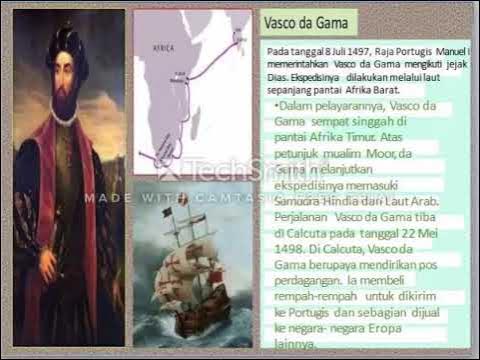Jalur Rempah Pada Masa Praaksara
Summary
TLDRThis video discusses the historical significance of the spice trade routes, known as 'Jalur Rempah', which connected the East and West. It explores the ancient maritime and trading networks that spanned over 15,000 km, starting from the eastern Nusantara to Europe, and highlights Indonesia's vital role in global commerce from as early as 4500 years ago. The script delves into archaeological and written evidence, including ancient records from China, India, and the Mediterranean, that showcase Indonesia as a key source of valuable spices. The video encourages pride in Indonesia's rich history and its lasting cultural legacy.
Takeaways
- 😀 The speaker, Ahmad Yanel Irsyad (Iat), introduces the history and cultural significance of Indonesia's spice heritage.
- 😀 Spices, particularly those from Indonesia, played a crucial role in global trade during the pre-colonial era and were highly valued by European colonizers.
- 😀 Indonesia's spice trade route, known as the 'Spice Route,' was a key trade and cultural exchange network, connecting the East and West.
- 😀 The Spice Route spanned over 15,000 kilometers, linking regions from Indonesia to the Mediterranean, Africa, and Europe.
- 😀 Indonesia was a central player in the global spice trade, with spices like cloves, nutmeg, and sandalwood, which were highly sought after in Europe.
- 😀 The Spice Route predates the Silk Road, with spices reaching China as early as 131 BCE, a century before the famous Silk Road was established.
- 😀 Archaeological evidence from Kalimantan, Indonesia, shows that the region's ancestors were skilled seafarers, navigating vast distances using early sailing techniques.
- 😀 Artwork from ancient sites, such as in Maluku and other parts of Indonesia, reveals early maritime connections and the trade of spices like cloves and nutmeg.
- 😀 Written records from India and Europe mention Indonesian spices, highlighting their importance in trade and cultural exchanges as far back as 300 BCE.
- 😀 Evidence such as ancient maps, hieroglyphs from Egypt, and writings from Roman sources confirm the prominence of Indonesian spices in ancient global trade networks.
- 😀 The legacy of the Spice Route demonstrates Indonesia's longstanding significance in world history, with a rich cultural and economic impact that continues to be celebrated.
Q & A
What is the significance of the spice trade in the context of Indonesia's history?
-The spice trade was a pivotal element in Indonesia's history, as it connected the archipelago to global trade routes for over 4,500 years. Spices like nutmeg, cloves, and pepper were highly sought after, making Indonesia a central player in the world's economy during the pre-colonial period.
What were some of the key spices traded along the spice route?
-Key spices traded along the spice route included nutmeg, cloves, sandalwood, pepper, cinnamon, and frankincense. These spices were highly valued for their use in food, preservation, and religious rituals.
How did the spice trade influence global exploration and technology?
-The spice trade led to advancements in maritime technology, including the development of navigational techniques and better shipbuilding. It also encouraged the rise of ocean exploration, with European and Asian nations seeking new trade routes to access spices from the East.
What was the spice route, and how far did it stretch?
-The spice route, or 'jalur rempah,' was an extensive trade network that connected Southeast Asia with Europe, Africa, and the Middle East. It spanned over 15,000 kilometers, stretching from Indonesia’s eastern islands to Europe via Africa and the Middle East.
What archaeological evidence supports the existence of the spice route?
-Archaeological evidence includes ship drawings and artifacts found in Kalimantan and Maluku, indicating that ancient Indonesians were skilled sailors. Additionally, the discovery of spices in ancient Egyptian tombs, such as black pepper, further supports the existence of early spice trade routes.
What role did written records play in confirming the spice trade's history?
-Written records from ancient India, such as the Ramayana, as well as Roman texts by authors like Pliny the Elder, confirm the presence of Indonesian spices in foreign markets. These texts mention the trading of spices like cinnamon, cloves, and sandalwood.
How did ancient civilizations, like Egypt, interact with the spice trade?
-Ancient civilizations like Egypt were involved in the spice trade, with evidence such as carvings in Egyptian tombs depicting ships bringing spices like pepper. Additionally, black pepper was found in the mummies of Egyptian pharaohs, suggesting its use for preservation and ritual purposes.
How did the spice trade affect the development of maritime exploration?
-The desire for access to spices led to the development of advanced maritime exploration. This resulted in the establishment of trade routes that connected distant regions, facilitating cultural exchange and the spread of new technologies across Asia, Africa, and Europe.
Why was the spice route more influential than the Silk Road?
-The spice route was more influential than the Silk Road because spices were more varied, affordable, and accessible compared to other goods traded along the Silk Road. The route also spanned a larger geographical area and was instrumental in shaping global commerce for centuries.
What cultural significance does the spice route hold for modern Indonesia?
-The spice route holds great cultural significance for modern Indonesia, as it highlights the nation's long-standing influence on global trade and its rich maritime heritage. Indonesians take pride in their ancestors' role in shaping global commerce and the nation's historical significance as a key player in the spice trade.
Outlines

此内容仅限付费用户访问。 请升级后访问。
立即升级Mindmap

此内容仅限付费用户访问。 请升级后访问。
立即升级Keywords

此内容仅限付费用户访问。 请升级后访问。
立即升级Highlights

此内容仅限付费用户访问。 请升级后访问。
立即升级Transcripts

此内容仅限付费用户访问。 请升级后访问。
立即升级浏览更多相关视频

B. JALUR REMPAH PADA MASA PRAKSARA | X SMA/MA | KURIKULUM MERDEKA

Yuk Belajar Sejarah Jalur Rempah-Materi Kelas X Fase E ✨

Sejarah Jalur Rempah: Rahasia Nusantara Jadi Pusat Perdagangan Dunia!

pertemuan ke 2, kolonialisme dan imperialisme

Kolonialisme dan Perlawanan bangsa Indonesia Sejarah Kelas XI Kurikulum Merdeka 2023

Video Pembelajaran Jalur Rempah Masa Kerajaan Tradisional (Sriwijaya dan Majapahit)
5.0 / 5 (0 votes)
